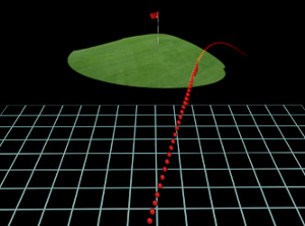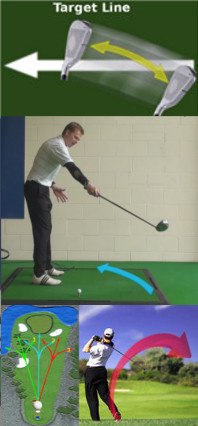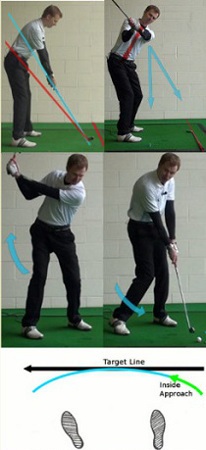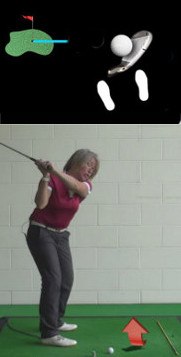If you are struggling with a slice, you are probably willing to try just about anything to improve your game.

There are few experiences in golf quite as frustrating as seeing the ball slice off to the right (for a right-handed golfer) time after time. Golf is a game and it should be fun, but it’s hard to enjoy yourself when every single shot you hit finishes with the same negative outcome. It is easy to give up hope when it feels like nothing you do manages to make a dent in your slice problem. There is hope, however, as long as you are willing to spend some practice time on the range making meaningful changes to your technique.
In this article, we are going to talk about one possible change you could make to your technique which may help straighten out your ball flight. The idea is relatively simple, even if executing on the idea will be rather challenging. The goal here is to flatten your swing plane, changing the way the club approaches the ball at the bottom of the swing. A relatively flat swing plane is likely to feel quite foreign to the average slicer, since most golfers who fight the slice use an upright swing – whether they mean to or not. If you can manage to successfully flatten your swing, there is a great chance that your slice will at least be reduced, and it may go away altogether.
Before getting into any of the details related to this idea, we first need to state clearly that making this kind of change is likely to be a long process. If you are hoping for instant results or a quick fix that will pay off in your next round, this is not going to be it. And, to be honest, you probably aren’t going to find that anywhere. One of the reasons so many golfers struggle for so long with the slice is the fact that they are constantly jumping from one quick fix idea to the next. It’s hard to fix a slice, and you have to be focused on long-term improvement if you are going to see results. Changing your swing plane is a significant challenge, and the results probably won’t be too exciting at first. However, if you can keep your long-term goals in mind, you may be able to see this through all the way to a dramatically improved swing.
All of the content below is based on a right-handed golfer. If you happen to play left-handed, please take a moment to reverse the directions as necessary.
Understanding the Slice

If you have any hope at all of fixing your slice, you first need to understand why the ball curves so dramatically to the right when it leaves your club. Unfortunately, many golfers never get past this first hurdle. Without a clear understanding of what is taking place, it is nearly impossible to get yourself on the right track. In this section, we aim to clear up any confusion you may have about the slice, so you can move forward with confidence and clarity.
When the ball curves dramatically to the right as it flies through the air, it does so because of a high left-to-right spin rate. In other words, the ball is spinning from left-to-right as it flies, and that spinning action causes it to turn toward the right rather than flying straight toward your target. So, quite obviously, your objective is to hit shots that do not include a significant amount of left-to-right spin. A little bit of this spin is just fine, as that will cause the ball to only fade gently to the right as it flies – a ball flight pattern which is used successfully by many golfers. It is only when the spin reaches excessive levels that the ball flight becomes unplayable and you’ll begin to struggle to have fun on the course.
The obvious next step, now that you know it is excessive left-to-right spin that causes the ball to slice, is to understand how that type of spin is created. Spin is a byproduct of the way the club moves through the ball at impact. There are two main variables that you need to keep in mind when discussing spin – face angle and swing path. Let’s talk about those two briefly –
- Face angle. As the name would indicate, this is the angle of the face at the moment that the golf club strikes the ball. You will always be talking about your face angle in relation to your target line. So, if the face is pointed directly at the target when you make contact with the ball, it is said to be in a ‘square’ position. If the face is pointing to the right of the target line, it is in an ‘open’ position. Finally, if it is pointing left of the target line at impact, it is in a ‘closed’ position. It is extremely important that you understand this concept, as it will be vital as you work toward eliminating your slice.
- Swing path. The path that the club takes through the ball is known as the swing path. A swing which moves directly toward the target is said to be heading ‘down the line’. Should you happen to swing out toward the right of the target, you will be swinging from inside-out. And, if you swing toward the left of the target, you will be swinging from outside-in, or ‘across the ball’. It is this last type of swing path that is most likely to be seen when talking about a golfer with a slice.
The combination of face angle and swing path will tell most of the story with regard to the kind of spin that you place on any given shot. If you were to make a swing where the face was perfectly square at impact and you swung directly down the line, the ball would have no side spin whatsoever. As you may already know, this kind of shot is virtually impossible to produce. You may hit a perfectly straight shot from time to time, but that is more by accident than anything else. Even professional golfers rarely try to hit completely straight shots, because striking the ball in this way is exceedingly difficult.
When your face angle strays from a square position, or your swing path is either outside-in or inside-out, you will start to see the ball curve. For instance, if you swing on an inside-out path with a closed clubface, you are almost certain to hit a draw or a hook. On the other hand, if you use that same inside-out path by the club face hangs open at impact, you will probably hit a push out to the right of the target.
For the majority of those hitting a slice, we are talking about a bad combination – an outside-in swing path combined with an open club face. This type of swing is always going to struggle to produce good shots, simply because it has so much working against it. The outside-in swing path tends to be rather weak, and the steep nature of such a swing is going to put a high rate of backspin on the ball. When you add that to an open club face, which is going to lead to excessive side spin, the outcome is sure to be ugly. If you are a slicer you already know what the final result looks like – the ball climbs high into the air while soaring way to the right of the target.
So, in the end, the picture looks like this – the club swings down from outside-in and cuts across the ball with an open club face. While the ball may start on line briefly as a result of this type of swing, it is going to quickly curve to the right after it takes off. To get rid of the slice, you are going to need to make a couple of changes. First, you will need to find a way to swing into the ball on a better path. That might mean still swinging from the outside-in, only less dramatically, or it may mean using an inside-out pattern. Also, you’ll have to find a way to square up the club face at the moment of impact. If you can do those two things, the slice will soon be an enemy of the past.
Why a Flatter Plane May Help

We hope you now have a pretty clear understanding of what is happening when you slice the ball off to the right of your target. It can be tough for some golfers to get their head around this subject, so keep thinking it through until you understand what is going on. With that important step out of the way, we can now talk about flattening your swing plane and how that adjustment may be able to cure your slice.
First, let’s define what it means to swing on a flatter plane. Basically, the shaft of the club is going to remain in a flatter position as it swings around your body. Rather than swinging the club high up into the air in the backswing, as you would do in an upright swing, you will keep the club lower and swing it back behind your right shoulder. There are pros and cons to this type of swing – a discussion which deserves its own article – but one of the notable pros is that it may be able to help those with a slice straighten out their ball flight once and for all.
The reason a flatter plane may be able to help you comes down to the altered shape of the swing. Since you are going to be swinging more around your back and less up in the air, it is likely that you’ll be able to approach the ball from the inside at the bottom of the swing. That means you should be able to break the outside-in habit, and one of the two issues that was leading to the slice will be eliminated.
At the same time, you may find it easier to release the club head through impact with a flatter swing, meaning you shouldn’t have as many struggles leaving the club face open. The rotation of the swing is relatively natural when you use a flat plane. That means your hands won’t have to be as active at the bottom in order to find a square position. With it being easier to square the face, and also easier to swing on a good plane, it’s not hard to understand why changing to a flatter plane is so attractive for many slicers.
Transitioning to a Flatter Plane

At last, we are going to get down to the business of helping you make this transition. If you have decided that using a flatter swing plane may indeed help you to eliminate your slice, this section is going to offer some tips on how you can do just that. While we hope these tips will help, we can’t guarantee that all of them will apply properly to your personal swing. You will have to think carefully about the tips, think about the current state of your golf swing, and use the ones that you feel will help you transition to a flatter plane successfully.
- Stand slightly farther from the ball. This is the big change that you should probably make right from the start. Standing a bit farther from the ball is going to naturally flatten your plane a bit, since the club will be in a flatter position at address. Of course, it is important to note that you don’t want to take it too far with this tip. You shouldn’t be standing so far from the ball that you have to reach out awkwardly at address just to place the club head behind the ball. Try moving back just an inch or so from your usual position and see how that feels. Make incremental changes until you land in a spot that feels comfortable and seems to promote a flatter swing.
- Quiet hands in the takeaway. One of the common mistakes seen in the amateur game is overactive hands during the takeaway. If you allow your hands to do too much of the work in the early part of the swing, you may move the club too far to the inside. As the swing continues, you’ll run out of room on the inside and eventually push the club up and away from your body at the top. This is the classic ‘over the top’ move that so many slicers are never able to get rid of. As part of your transition to a flatter swing, try turning your shoulders away from the target to start the swing, without much (if any) input from your hands. This might feel a bit awkward at first, but you should get the hang of it after some practice.
- Make a great shoulder turn. The shoulder turn really is the key to this entire plan. If you can use your shoulders effectively as the engine of your golf swing, you’ll stand a great chance to be successful. If you fail to use your shoulders correctly, however, the club is going to have to swing high into the air because it won’t have room to stay on the flatter plane. Focus on the shoulder turn as you go back away from the ball and give yourself plenty of time to complete the turn properly. Many golfers rush through the backswing and are unable to finish their shoulder turn as a result. It should be noted that you don’t have to make the longest turn in golf in order to get good results. Turn as far back as your flexibility will allow without forcing yourself to fall off balance.
- Use your legs for support. All golfers should use their lower bodies for support, no matter what kind of swing plane they are attempting to use. However, it is particularly important for golfers who want to use a flat swing plane to engage their lower bodies nicely. Flex your knees at address and keep them flexed all the way through the backswing and into the downswing. This is going to establish a great platform for your swing, and it will help you turn through the ball aggressively as you move toward the target.
There is nothing particularly complicated about swinging on a flatter plane, but it is sure to take some effort to figure this out for yourself. Those who are used to an upright swing plane will feel that everything is all out of sorts when they flatten out their path. The only way to get over the initial awkward feelings is stick with it one range session after the next. You’ll have some struggles along the way, to be sure, but be positive and look forward to making progress and gradually seeing your slice reduced to just a fade – or maybe, it will even turn into a draw.
Getting Back onto the Course

At some point, you will need to take what you’ve learned on the driving range and move it out onto the golf course. You’ll probably be excited for this opportunity, especially if you have made good progress in practice. However, while there is nothing wrong with being excited, you do want to temper that excitement with some realistic expectations.
It is hard to play golf in a different way than you’ve played it in the past. Even though it is a good thing to get rid of your slice, you are still used to playing golf with that slice. You’ve grown accustomed to aiming out to the left of the target and letting your ball curve back. You are used to the fact that you don’t hit your shots particularly far, since much of your distance potential is lost while the ball is veering off to the right. It is great to have rid yourself of the slice and the problems it presents, but that doesn’t mean you will automatically be playing great golf in your next round.
There are a couple of problems that you need to be concerned with when you head out onto the course with your new, flatter golf swing. The first issue is all of the technical adjustments you will need to make. It won’t make sense to aim to the left of the targets anymore, so you will have to get comfortable aiming straight and trusting your swing. Also, you should have picked up some distance in the process, so club selection could be a bit of a challenge, at least at first. These issues will get better as you spend more time on the course, but they’ll be a struggle at first.
The other issue to keep in mind is one of trust. Even though your old swing wasn’t particularly sound from a technical standpoint, it was the swing you trusted. You may have had hundreds or even thousands of rounds of golf under your belt with that swing. It’s one thing to build a new swing on the driving range, but it’s another thing entirely to actually trust that swing when you are on the course. Do your best to believe in the new swing plane you are using, and remind yourself of all the great shots you’ve hit in practice when you are struggling to maintain confidence during a round.
We hope the idea of moving to a flatter swing plane is one that you are able to use effectively in an effort to get rid of your slice. The game of golf can be tremendously enjoyable for a variety of reasons, but it’s hard to have a lot of fun when you are slicing one ball after the next. Be patient with yourself as you work on this swing change and hopefully it will pay off in the long run. Good luck!





